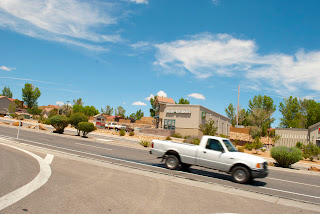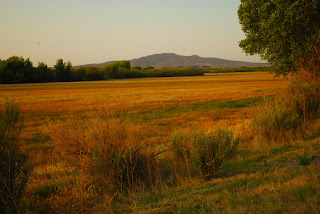 |
| Río Chama |
The Rio Grande has a close cousin with a common birthplace in the San Juan mountains of Colorado: the Río Chama. Although it is a short river only 135 miles in length, the Chama is vital to the ecosytem and to life on the Rio Grande because it functions as a collector of water from a number of streams and smaller rivers in the Tusas Mountains of northcentral New Mexico. Like the Rio Grande into which it empties, it helps to bring snow melt from The San Juan mountains to the fertile valleys through which it passes. But the Chama is not merely functional. In 1978, it was designated by the U.S. Congress as a “wild and scenic river” a designation that has helped protect the scenic beauty and clear waters of the region.
 |
| Frank fishing for trout with his buddy on the Chama |
 |
| Tony will soon catch a beauty! |
We met two fishing buddies Frank and Tony, retired policemen.
The Chama River Valley is located partially in Rio Arriba County. During the height of the Civil Rights movement in the 1960's, the town of Tierra Amarilla was the setting of a confrontation between residents of Río Arriba and the U.S government. A charismatic itinerant preacher, Reies López Tijerina, led a citizen revolt which made claims to the use of public lands dating back to the Spanish colonial period. The land in question was set aside for use as common grazing grounds without private ownership. After the war with Mexico, the U.S. government converted these ejidos into national forests and limited grazing, woodcutting and water use practices by the locals most of whom were small farmers. Tijerina sought to restore the ejidos to their original purpose but failed to do so through legal channels. He led an armed raid against the Rio Arriba Courthouse in Tierra Amarilla. Gunfire erupted with two government officers wounded. Tijerina fled into the mountains. Pursued by government troops who failed to apprehend him, Tijerina surfaced in Albuquerque where he surrendered to the authorities. He was released only on condition that he end his leadership of his insurgent group.
 |
| Río Arriba Country Courthouse |
Although he was supported by leaders of the Chicano movement of the 60s and 70s, the latter had different goals. Tijerina and his followers were chiefly Spanish Americans who did not identify culturally with the Mexican history of the area. They prefer the term “Spanish American" in recognition of their unique history. The ejidatarios who formed the bulk of Tijerina's followers trace their roots in the Chama Valley to Spanish settlers who arrived nearly 400 years ago.
Abiquiú
We drove to the Chama Valley on Route 84/285 from the town of Española. A highlight of our visit to North Central New Mexico was the town of Abiquiú. The town was once an Indian Pueblo (Ha'agizh in Navajo) where Spanish settlers built their city on the same site. The town resembles an idle movie set. Where once 2,000 residents enjoyed the beautiful views, now a mere 40 families reside. Abiquiú's unique setting has attracted film makers. Half a dozen movies and most recently an episode of Breaking Bad (http://www.aoltv.com/2010/05/30/breaking-bad-abiquiu-recap/) have been filmed here.
 |
| Santo Tomas Apostol Church |
An important resident who came to Abiquiú in 1949 from New York City was Georgia O'Keefe (1887-1986), one of the nation's most acclaimed painters. The beauty of this region was captured by O'Keefe in many of her paintings. As a result, Abiquiú and its neighboring towns have become a magnet for artists and art dealers.
 |
| Grounds of Santo Tomás Apostol Church |
One of the few remaining vestiges of early European history was the original church at Abiquiú. Located high on a hill overlooking the valley below. With the exception of electric lights and telephones the town has made few concessions to modern life. It has no paved streets or fast food outlets. The town is situated on a spur of the Camino Real that connects the region to other Spanish settlements in California.
 |
| As luxurious as they get! |
 |
| Nearly 400 year-old Abiquiú Mission |
 |
| Abiquiú Mission |
Its long history notwithstanding, the most important feature of the Chama Valley is its natural beauty. Located less than 100 miles from the state capital at Santa Fe, it was surprising to find this bucolic setting so close to the busy streets of Santa Fe.
 |
| Río Chama in all its glory! |
 |
Vista from NM Route 84
|
















































